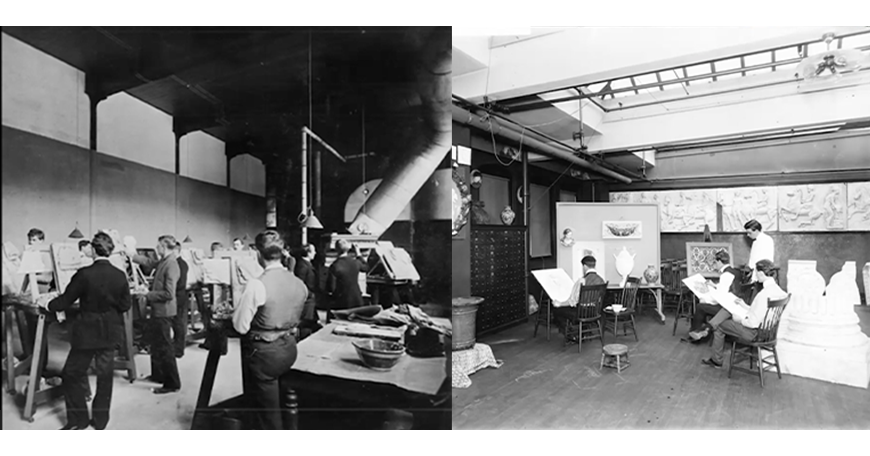Virtualizing Project-based Learning in Architecture

Before the MIT Department of Architecture transitioned fully to remote education in mid-March 2020, and even before it became the first academic program in architecture in the United States in 1868, students of architecture have consistently found success through physical project-based learning. “This has to do with everything from the neurology of creativity to the social nature of learning,” emphasizes Nicholas de Monchaux, Professor of Architecture and Urbanism. “Students will always learn more from each other, especially in shared environments, than they ever will from us.”
As the newly appointed department head, de Monchaux has led Course 4 through the challenge of adapting project-based learning to remote, virtual studios. He has synthesized four key lessons to inform further remote teaching across the department.
Lesson 1: Sometimes simulating physical space in the digital realm works.
Through experimentation, the most successful Course 4 classes have found ways to simulate physical experiences digitally. For example, students have used tools like Mural or Miro to replicate the experience of pinning up their work and co-designing. Instructors have employed video conferencing and on-screen annotations to review student illustrations live and lead engaging discussions on design. They have often achieved this through multi-device setups, such as the one depicted below.

“These [innovations] are no substitute for doing this in person,” de Monchaux acknowledges. “But I realized they serve as a kind of methadone for the real life high of in-person collaboration.”
Lesson 2: Sometimes replicating physical spaces and encounters too literally can be counterproductive.
Studio sessions in Course 4 typically last four hours. Virtualized studios found that the experience of working intensely alongside each other for hours in a shared physical environment did not translate well to Zoom. Instructors addressed this by breaking the video conference sessions into shorter sections with frequent breaks and smaller group interactions. De Monchaux finds that this adaptation more closely compares to “the amorphous ebb and flow of discussion in physical space.”
Lesson 3: Talking about spaces and places without accessing spaces and places is particularly hard. Course 4 instructors have not only needed to compensate for the loss of physical studio space, but also for the inability to visit other places and spaces.
In Urban Design Studio (11.332J / 4.163J), Associate Professors Arindam Dutta and Brent Ryan focused on data as a means to understand the complexity of an urban environment. Their students examined the adaptive reuse of abandoned industrial spaces along the Hooghly River of Kolkata. These abandoned mills are inaccessible even to those physically in India, regardless of pandemic restrictions. In this instance, the limitations of remote teaching did not interfere with pedagogical goals, as accessing the physical space would have been impossible even in normal circumstances.
Students are also remotely connecting to their subject in Architecture Design Option Studio — From Ocean to Table: Thai Coastal Urbanism (4.154). Associate Professor Miho Mazereeuw has facilitated virtual exchanges with residents of communities in coastal Thailand, in which the distance between students and residents is bridged through residents sharing their homes, cuisine, and work life on video.
Lesson 4: Architecture is important, but what is most important is the architecture of experience.
The experience of learning extends far beyond the subject matter. Professor de Monchaux reflects that perhaps the one of the biggest challenges facing Course 4 is the loss of serendipitous encounters and the ambient learning that happens in shared physical environments.
Architecture students, however, are rising to the challenge. Beyond holding the standard Zoom “happy hour” for socializing, students have developed methodologies such as sudden random breaks into small breakout rooms. The new student-run radio station, What Are We Doing (WAWD) Radio, stands as yet another example of students’ deep, intuitive understanding of their own learning needs. The station attempts to replicate the ambient environment of creative spaces, streaming student-curated music and including meditations on architecture with both students and faculty.
Considering the crucial role that students have played in smoothing the transition to remote learning, de Monchaux notes that “we learn from our students as much as they learn from us.”
Looking Forward
As MIT instructors look to the fast approaching fall semester, de Monchaux ponders MIT’s decision – over 100 years ago – to build its current campus and transform itself. Similarly, the MIT community must now reimagine and transform all of its fixed student experiences, from curricular structures to physical spaces. To de Monchaux, the one fixed quality that matters is the quality of the student experience. He recognizes that a far greater level of change is still required to raise the quality of this experience across the department and institute, especially supporting areas that have faced more challenges in the transition to remote teaching and learning.
Ryan MacDowell, TLL Communications Strategist and Project Coordinator

